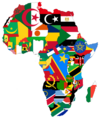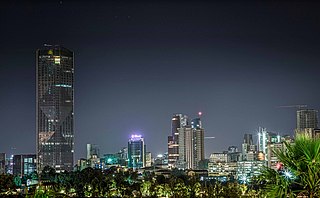
Addis Ababa is the capital and largest city of Ethiopia. In the 2007 census, the city's population was estimated to be 2,739,551 inhabitants. Addis Ababa is a highly developed and important cultural, artistic, financial and administrative centre of Ethiopia. It also serves as the capital of the Oromia Region.

Addis Ababa University (AAU) is a national university located in Addis Ababa, Ethiopia. It is the oldest university in Ethiopia. AAU has thirteen campuses. Twelve of these are situated in Addis Ababa, and one is located in Bishoftu, about 45 kilometres (28 mi) away. AAU has several associated research institutions including the Institute of Ethiopian Studies. The Ministry of Education admits qualified students to AAU based on their score on the Ethiopian University Entrance Examination (EUEE).
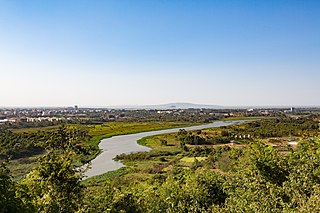
Bahir Dar is the capital city of Amhara Region, Ethiopia. Bahir Dar is one of the leading tourist destinations in Ethiopia, with a variety of attractions in the nearby Lake Tana and Blue Nile river. The city is known for its wide avenues lined with palm trees and a variety of colorful flowers. In 2002, it was awarded the UNESCO Cities for Peace Prize for addressing the challenges of rapid urbanization.

Berhanu Nega is an Ethiopian politician who is serving as the current Minister of Education of Ethiopia. He previously was the mayor elect of Addis Ababa, Ethiopia, in the 2005 Ethiopian general elections. He is a founding chairman of the Rainbow Ethiopia: Movement for Democracy and Social Justice and a Deputy Chairman of Coalition for Unity and Democracy (CUD), for whom he served as chief election campaign strategist. He is also the co-founder and leader of Ginbot 7, an anti-government rebel group. Until mid-2018, he was labelled a terrorist by the Ethiopian government.

Jimma University (JU) is a public research university located in Jimma, Oromia Region, Ethiopia. It is recognized as the leading national university, as ranked first by the Federal Ministry of Education for four successive years (2009–2012). The establishment of Jimma university dates back to 1952 when Jimma college of Agriculture was founded. The university got its current name in December 1999 following the amalgamation of Jimma College of Agriculture and Jimma Institute of Health Sciences.

Haramaya University (HU) is a public research university in Haramaya, Oromia Region, Ethiopia. It is approximately 510 kilometres (320 mi) east of Addis Ababa, Ethiopia. The Ministry of Science and Higher Education admits qualified students to Haramaya University based on their score on the Ethiopian Higher Education Entrance Examination (EHEEE).

Universitas Terbuka is Indonesia state university and employs Open and Distance Learning (ODL) system to widen access to higher education to all Indonesian citizens, including those who live in remote islands throughout the country, as well as in various parts of the world. It has a total student body of 1,045,665. According to a distance education institution in the UK, which published "The Top Ten Mega Universities", UT-3 ranks closely with universities from China and Turkey.
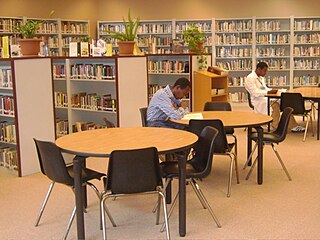
The International Community School of Addis Ababa is an international school in Addis Ababa, Ethiopia founded in 1964.

Hawassa University (HU) (Amharic: ሀዋሳ ዩኒቨርሲቲ) is a residential national university in Hawassa, Sidama Region, Ethiopia. It is approximately 278 kilometres (173 mi) south of Addis Ababa, Ethiopia. The Ministry of Science and Higher Education admits qualified students to Hawassa University based on their score on the Ethiopian Higher Education Entrance Examination (EHEEE).
Admas University is a tertiary institution based in Addis Ababa, Ethiopia. It was established in 1998.

Education in Ethiopia was dominated by the Ethiopian Orthodox Church for many centuries until secular education was adopted in the early 1900s. Prior to 1974, Ethiopia had an estimated literacy rate below 50% and compared poorly with the rest of even Africa in the provision of schools and universities. After the Ethiopian Revolution, emphasis was placed on increasing literacy in rural areas. Practical subjects were stressed, as was the teaching of socialism. By 2015, the literacy rate had increased to 49.1%, still poor compared to most of the rest of Africa.
St. Paul's Hospital Millennium Medical College is Health Sciences teaching institution at St. Paul Hospital, Addis Ababa Ethiopia.

Donald Nathan Levine was an American sociologist, educator, social theorist and writer at the University of Chicago, where he served as Dean of the College. Within sociology, he is perhaps best known for his work in sociological theory and his translations and interpretations of Georg Simmel's classical texts into English, which led to a resurgence of interest in Simmel's work in the discipline. He was also a central figure in Ethiopian Studies.
The following is a historical events of Addis Ababa, the capital of Ethiopia, including its formation prior to 20th century by chronology.
Addis Ababa Science and Technology University, or AASTU, is an Ethiopian higher institute in Addis Ababa, Ethiopia. The main campus is located in the Akaky Kaliti subcity, Kilinto area.
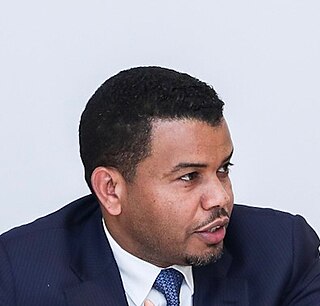
Takele Uma Banti is an Ethiopian politician who had served as the Minister for Mines Petroleum of Ethiopia from 18 August 2020 to 14 January 2023. He was the 31st Mayor of Addis Ababa who came to prominence for his transformational way of doing business and his visionary leadership roles after Ethiopia's reform by the current leadership of the country starting 2018.
Mulu Nega Kahsay is an Ethiopian academic and politician. Mulu Nega was one of the federal Ethiopian State Ministers of Science and Education in 2020. In November 2020 during the Tigray conflict, the House of Federation appointed Mulu Nega to replace Debretsion Gebremichael, chief executive of Tigray Region, with Mulu Nega becoming chief executive of the Transitional Government of Tigray. He held the position through to May 2021.

Opposition to Haile Selassie relied largely of internal administration of his country. While Haile Selassie made attempt to modernize the country and brought to global power since Italy's occupation in 1936–41, the later administration met with negative public attitude especially among educated people in universities and peasants.

The Addis Ababa City Administration is a government executive organ of Addis Ababa, the capital of Ethiopia. It is governed by mayor, and the lowest administrative unit is the woreda, led by a woreda administrator. As a federal structure the woreda administration has an elected council.

Higher education in Ethiopia is the lowest in quality of standard relevance and academic freedom, despite an expansion of private higher education and rising enrollment. Higher education supposed originated by Saint Yared music school in the sixth century in line with centuries old traditional education of the Ethiopian Orthodox Tewahedo Church. Modern higher education was commenced during the reign of Emperor Haile Selassie with the establishment of the University College of Addis Ababa, now called Addis Ababa University in 1950. It then followed by Haramaya University. By the time, there were only three secondary schools in the country, used as preparatory for college entrance.















